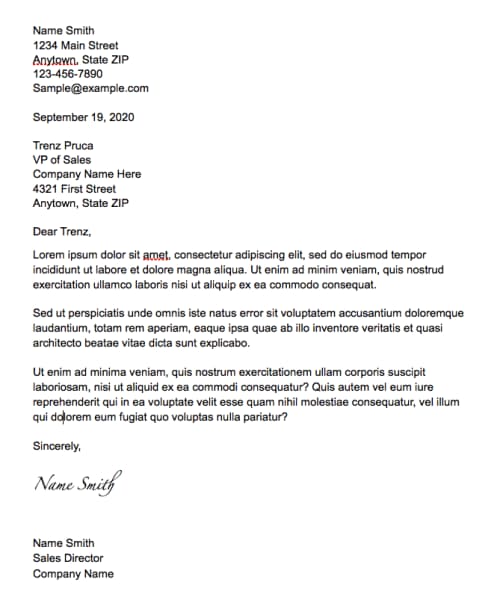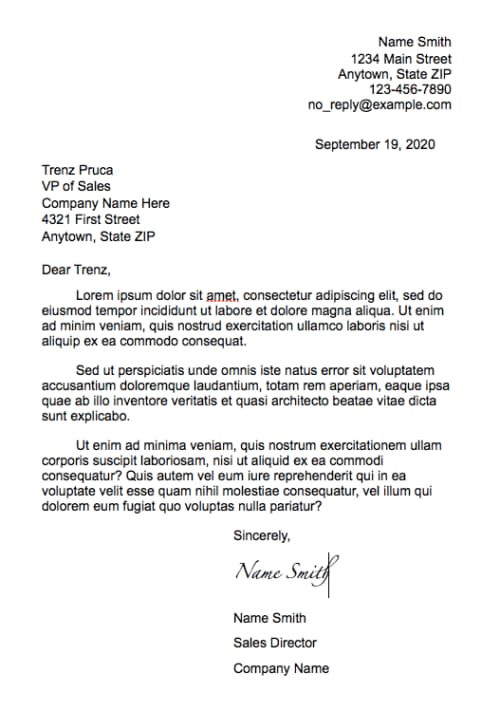How to Write a Business Letter: Format, Examples, and Bonus Tips
Every time you begin typing a business letter, you find yourself googling different formats and styles. Should you adhere to a specific number of paragraphs? What info should you make sure to include, and how personal should your letter be? What’s the most appropriate way of addressing and closing your note?
If you have no clue as to how to answer these questions when you sit down to write a formal business letter, we’re not judging you. In fact, we’ve been in your shoes so many times that we decided to put together a guide on how to write a business letter so it's no longer a mystery.
What is a business letter
A business letter is a formal written communication between two or more individuals, organizations, or entities for business purposes. Typically, it is used to discuss professional opportunities and proposals, such as collaboration or partnerships between companies. Unlike regular professional emails, business letters have a standard format that includes a formal salutation, contact information, full date, signature, and a call to action.
Types of business letters
There is a vast range of business letters due to the endless possibilities of business communication. However, some types of business letters are more commonly used than others. Here are a few examples:
Sales letter: Used by business to pitch a product or service to potential customers or clients.
Inquiry letter: It's a formal way to request more information about a product or service.
Offer letter: Sent by hiring managers to approved job applicants to formalize their hire.
Letter of recommendation: A senior professional who can vouch for someone's work sends this letter to potential employers.
Cover letter: An introduction letter that job applicants send to employers along with their resumes.
Resignation letter: It's a formal way to communicate to human resources that you are quitting your job and giving notice.
When to use a business letter
Before we talk about the business letter format, let’s take a look at what situations require them. They are typically used when you’re writing to formally discuss professional opportunities, particularly if you’re drafting a hard copy as opposed to an email.
For example, if you’re sending a thank you note after a job interview, you can simply send a brief, professional email rather than writing a formal, formatted business letter. But if you’re writing a recommendation letter for someone who used to report to you at work, or if you’re submitting an official resignation letter, you’ll want to craft a legit and professional letter so that both you and the reader can keep a record of the message with detailed contact info.
As a letter sender who's writing with a particular intent, you also want to address and close your letter appropriately—even if you're on a first-name basis with the person to whom you're writing—to make a good impression.
Parts of a business letter
Like any formal document, a business letter follows a specific structure that you'll find in all types of business correspondence. It includes six key elements and pieces of information:
1. Heading
The business letter heading is essentially the opening of your letter and is the first thing the receiver will see. It stays at the top of the page, typically aligned to the left and justified, and it should include the following basic information:
Your name
Your address
Your contact information (phone number, email address)
Date
The recipients contact information
2. Salutation
Needless to say, every formal communication between two parties should start with a salutation. Don't be overly formal to the extent that you sound like a character from a 19th-century movie, but also avoid being too casual. A simple “Dear, [Name]” is enough.
It's ideal to address someone specific—but if you can’t find the name of a contact, you may use something general. For instance, you might write “Dear Hiring Manager” in a cover letter if you’re not sure of who will be opening and reading your note). Always address a person or, at very least, a department, avoiding the rude and outdated “To whom it may concern.”
If you do know the recipient’s name but are unsure about their gender, there are ways to get around writing “Mr. or Ms. or Mrs.” Rather than guess and risk addressing your reader incorrectly, you can simply write out a full name (for example, you can type, “Dear Taylor Jones”).
3. Body
This is the content of your letter, where you state the reason for contacting the recipient or company. Here, you introduce yourself, pose your question, present your business proposal, or communicate your resignation—depending on the purpose of your letter.
5. Closing
The closing paragraph should outline the next steps for the reader. Perhaps you want them to contact you to schedule a virtual or in-person meeting, or a phone call. Essentially, it should involve a call to action, such as “let me know when we can meet for a coffee.” Next, end it with a formal sign-off such as “Best regards” or “Sincerely.”
6. Signature line
Whether you are sending a physical or digital letter, it's recommended to include a handwritten signature followed by your typed name and job title. For digital signatures, there are apps and websites that allow you to sign documents digitally using a cursive font or by uploading your actual handwritten signature.
How to write a business letter: 3 tips
The actual writing of a business letter will naturally vary depending on its type and purpose. However, there are a few details to keep in mind when drafting your message.
1. Do your due diligence
Before you start typing your letter, take time to gather all relevant details about the receiver. Whether you're proposing a business partnership or applying for a job, it's important to address the correct person or department by name. This demonstrates your genuine interest in connecting with them for specific reasons, rather than sending automatic, generic letters to anyone.
2. Be clear and concise
Keep your letter as brief and concise as possible. In your introductory paragraph, get right to the point by explaining the purpose of your letter. Each subsequent paragraph should go into detail about the intent behind your letter, whether it’s an explanation, request, or both.
Your final paragraph should clarify the main point of your letter, and if you’re asking for something, make sure your request is clear as you conclude your message. You should also be gracious here—thank the recipient for taking the time to read your note and consider your request.
3. Use a professional tone
Be mindful of keeping a professional tone throughout your entire letter. It's easy to unintentionally slip in informal expressions that can make you look unprofessional or childish. Remember, you don't need to be overly formal and use academic language—just keep it professional.
How to format a business letter
When you write a formal letter, whether it's a business proposal, recommendation letter or some other type, you can use one of these three formats:
Block: In this format, the entire text is left-justified without indentation in the first line of each paragraph. Instead, you'll add extra space between paragraphs, ranging from 1" to 1,5".
Modified block: Letters with modified block formats have the heading, sign-off, and signature on the right side of the page. The body paragraphs stay on the left with the same spacing as the block format, 1" or 1.5".
Semi-block: This format is quite similar to block style, except that every new paragraph starts with an indented first line (usually 0.5"). Regarding spacing, aim for 1.5" or 2" to enhance readability.
Last but not least, choose a simple font (Times New Roman or Arial are good examples of plain font styles) in size 10 or 12 points.
Business letter examples and templates
Below is a sample business letter that will help you understand the formal business letter format, including what details are necessary to include. You’ll also find the correct format for each section of your letter, including the contact information, your greeting or salutation, and your closing.
Sample 1: Block Business Letter Format (Standard Format)

Block business letter template
Your name
Your address
Your phone number
Your email address
(include one extra line of space here)
Date (type out the date in full: “January 1, 2019” as opposed to “1/1/19”)
(include one extra line of space here)
Recipient’s name
Recipient’s title
Recipient’s company name
Recipient’s address (or company address)
(include one extra line of space here)
Dear Ms. Smith (use a formal greeting or salutation unless you have a close, first-name basis relationship with the person to whom you're writing. Be sure to include a colon rather than a comma after the recipient’s name as this is the more formal salutation punctuation.)
(Write the body of your letter)
(Leave two lines between the bottom of the last paragraph and the close.)
Sincerely,
(Leave an extra black space here—four lines, ideally—so you can add a handwritten signature above your typed name and title)
Your name (typed)
Your phone number
Your email
Your title (if applicable)
Your company name (if applicable)
Sample 2: Modified block format
Unlike the block-style business letter layout, in which the full body of the letter is stylized in the left margin, a modified block letter involves indenting the sender address and date in the letterhead to the right margin. Typically, this format doesn't have indent paragraphs, but you can style it this way. For example:

Modified business letter template
Your name
Your address
Your phone number
Your email address
(extra line of space here)
Date (typed out in full)
(one extra line of space here)
Recipient’s name
Recipient’s title
Recipient’s company name
Recipient’s address (or company address)
Dear Ms. Person:
(Leave two lines between the bottom of the last paragraph and the close.)
(Tab to the center of the page for the close and signature block, usually 3” or 3.25”) Sincerely,
(Leave an extra black space here—four lines, ideally—so you can add a handwritten signature above your typed name and title. If you're not signing your name, you only need one space below “Sincerely”)
Your name (typed)
Your title (if applicable)
Your company name (if applicable)
Sample 3: Semi-block format
Here's a business letter template with the semi-block formatting style. The semi-block format includes all the same elements as the other styles, but requires different styling for each new paragraph:
Your name
Your address
Your phone number
Your email address
(extra line of space here)
Date (typed out in full)
(extra line of space here)
Recipient’s name
Recipient’s title
Recipient’s company name
Recipient’s address (or company address)
Dear Ms. Smith:
(Write the body of your letter, starting every new paragraph with an indented first line)
(Leave two lines between the bottom of the last paragraph and the close.)
Sincerely,
(Leave an extra black space here—four lines, ideally—so you can add a handwritten signature above your typed name and title)
Your name (typed)
Your phone number
Your email
Your title (if applicable)
Your company name (if applicable)
Extra business letter formatting tips
As you may imagine, a business letter is not the place to be sloppy. As a letter sender, consider what you'd look for as red flags if you were on the other side reading it. Triple check for typos or grammatical errors—readers might take your message less seriously if it’s not well written and articulated. In addition, review the spelling of your recipient’s name (if you misspell their name, you’re increasing the chances that your letter winds up in the trash!).
There are a few ways to make sure your letter is as clean as possible. Beyond reading it over a few times on your screen, try printing it out and reading a hard copy. Read the letter aloud, and, ideally, have someone else (with strong editing skills) proof your note for you.
Make sure you’ve added your written signature (stick to blue or black ink for this) and double check that your formatting looks clean and consistent (for instance, you must have the same amount of space between each paragraph).
Bottom line
Now that you know what you’re doing, hopefully, you no longer dread writing this kind of business correspondence. As the template above should indicate, writing a business letter is actually way more simple than you might imagine.
Yes, it must be formal and formatted in a particular manner, but once you’ve reviewed and followed an example, you’ll get the hang of it and realize this kind of letter writing is really not such a pain.
In fact, it’s sometimes easier to follow a format than to write something more open-ended, especially when you’re not sure about the formality level. Mastering the art of the business letter is a great investment that’s not particularly time-consuming, and it’s a skill that will go a long way throughout your entire career.
Why women love us:
- Daily articles on career topics
- Jobs at companies dedicated to hiring more women
- Advice and support from an authentic community
- Events that help you level up in your career
- Free membership, always
